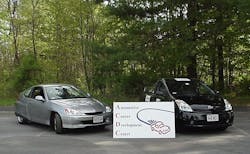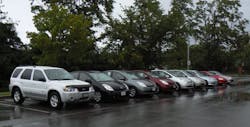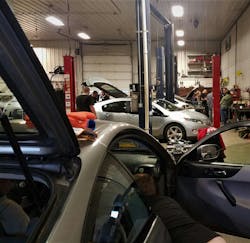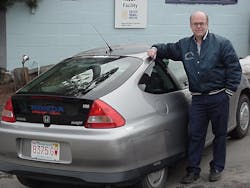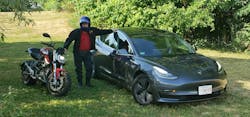Key Highlights: Technicians Need to Know
- The Honda Insight, introduced in 1999, was one of the first hybrid vehicles and gained a cult following due to its innovative design and technology.
- Toyota's Prius, launched in 1997, became a mainstream hybrid, with over 1.3 million units sold in the U.S. by 2015.
- Hybrid technology evolved through collaborations between automakers like Ford, Toyota, and Volvo, leading to more efficient and versatile hybrid systems.
- Advancements in lithium-ion battery technology over the past 15 years have significantly increased EV range, reduced costs, and improved longevity.
- Modern EVs now offer over 300 miles of range, fast charging capabilities, and are becoming more affordable, making electric transportation practical for many consumers.
What has happened with EVs since their birth in the late ‘90s? This is a technical walkthrough of the evolution of hybrid that led to EVs, including the last 15 years of lithium packs and planning for the future.
A Cult Hybrid
The original Honda Insight has a “cult” like following. How did this odd-looking hybrid attract so many fans? Honda introduced the first hybrid to America in December 1999. It was a month that changed a lot of what we thought we knew about cars. The first generation of the Insight was discontinued in 2006. The Insight prototype, by another name, was first shown to the public at the Tokyo Auto show in 1997. It was a two-passenger sports coupe. It had been in development for about three years prior to that. In the summer of 1999, it was named the Insight and Honda released the details. Before they were sold a few Insights were available to reporters and others for road testing. Stan Stephenson, former editor of Motor Age magazine, and a member of IMPA (International Motor Press Association) had a pre-production Insight in October of 1999. He called me at my home is Worcester, Mass. and I flew down to Philadelphia, Pa. the next day for my first drive in what would become my first of many hybrid car purchases.
First year sales were limited to less than 6,000 hybrids due to a lack of production ability. Insights were made in Japan in the same small factory that built the NSX and the S2000. It had an all-aluminum chassis and was very high tech for its time in regards to aerodynamics, engine, hybrid software, and electronics. The first year it was only available with a five-speed manual transmission. A little Honda History: Honda's first use of the Integrated Motor Assist (IMA) system was for F1 racing. This was to add more torque to the ICE coming out of the corners when rpms are low and torque is not enough to get maximum traction. It never saw a race as it was not allowed. This type of system was finally used by F1 in 2009. If you haven’t been keeping up with Formula One racing, take a look and while you are there, check out Formula E. Adding more torque electrically to the crankshaft works great as Honda has proven on and off the track. This Insight was light weight, streamlined, and efficient. It handled well and ran like a Honda. The old Insight was one of a kind.
In December 1997 Toyota introduced the first mass-produced hybrid vehicle as a M/Y 1998 to the drivers in Japan. In model year 2001 it was brought to North America. Sales of the first-generation Prius were slow as it was a new idea at a time when gasoline was $1.50 per gallon and there were no government financial incentives. Sales increased drastically when the second generation was sold in 2003 as a M/Y 2004. Some local, state and federal governments worldwide stepped in to help lower the cost of ownership. Some HOV (High Occupancy Vehicle) lanes were opened to hybrids with only the driver. These incentives were debated and some people that loved the old days objected. The hybrid incentives went away years ago. Today the incentive is all about plug-in cars and those are still debated.
The Gen III Prius liftback (M/Y 2010-2015) sold over 1.3 million units in the USA without any incentives and became a mainstream car. The first Prius was an original idea. Toyota deserves all the credit it has been given to bring a modern hybrid car to the masses. Its aerodynamic shape, particularly the second generation, made it stand out. Unlike the Honda Insight, which was the only other HEV at that time, the Prius was a family car that could carry up to five passengers. The second-generation Prius was larger and provided enough interior space to be classified as a mid-sized vehicle. The Prius has also been certified as a SULEV, or Super Ultra Low Emission Vehicle.
Toyota hybrids sold very well in 2024 as the company now offered hybrid versions of all of the important models it sells, except the low volume Toyota GR 86, Supra, and Lexus IS. In M/Y 2025 the Camry, Land Cruiser, Sienna, Venza, RAV4, and Sequoia are only available as hybrids in America.
Next up with hybrids was Ford. In 2004, Ford released the M/Y 2005 Escape hybrid. This was the first hybrid SUV, and the first hybrid vehicle built in North America. Sales of the hybrids went very well, although they were in limited simply because of a shortage of hybrid parts from Japan. The Ford Escape SUV received many accolades and looked nearly identical to the non-hybrid Escape. The major differences in appearance are badges or external markings that say it is a hybrid and a barely noticeable vent near the rear quarter window on the driver’s side of the vehicle until 2010. The vent was there as an inlet for the HV battery evaporator. The standard Escape hybrid is front-wheel drive, and an Intelligent 4WD system that is optional (Figure 15-29). This option made the Escape the first 4WD hybrid.
In 2006, Ford released a hybrid version of the Escape’s cousin, the Mercury Mariner. These SUVs feature a transmission that was designed by Volvo and Aisin. The Toyota eCVT was similar in design and function to the Ford unit. Aisin, a Japanese company, was involved in both hybrid systems during development in the '90s. This Ford hybrid had the technology, as well as the ability to be powered solely by battery power. They have a towing capability of up to 1,000 pounds, the same tow rating as a regular four-cylinder Escape or Mariner. The last model year for the Escape HEV was 2012. Ford, Volvo, Aisin, and Toyota all worked at times on the basic components and operation of Ford’s hybrid system as they are very similar to what is found in Toyota hybrids. This has led many to conclude that Ford was simply buying the system from Toyota. This was not true. The concept of using two electric motors to create a transaxle suitable for hybrid technology was first explained by an American engineer in the 1960s. This concept is actually an adaptation of the planetary gear set Henry Ford used in the original Model T in 1909. Going forth with the basic idea of using a planetary gear set as a power-split device, Toyota entered into a partnership with a Japanese transmission design and manufacturing company, Aisin, in the early 1990s to develop a hybrid transmission with two electric motors. These companies continued to work together for years (until their contract expired), and then Toyota decided to continue development of the transaxle on its own. The result was the transaxle introduced in the 1998 Prius.
In the meantime, Volvo joined forces with Aisin and continued to develop the eCVT transaxle. In 1999 Ford purchased Volvo and the technology. Because of the basic roots, the Toyota and Ford power-split units are quite similar. Due to the similarities and to avoid legal problems, Ford licensed some of the technology from Toyota and Toyota licensed some technology from Ford. Toyota holds over 150 patents on the technology, and Ford has received more than 100 patents on its design.
The bottom line: Aisin supplies the transmission used in the Ford Escape hybrids and Toyota makes most of their own eCVTs with Aisin helping out on the Lexus GS and LS hybrid models. Toyota does not supply hybrid components to Ford. Both Ford and Toyota state that Ford received no technical assistance from Toyota during the development of their hybrid system.
At General Motors, the 2-Mode transmission uses three planetary gear sets, two motors, and a similar approach as the Prius in terms of cranking the ICE to start and also the constantly variable ICE to road speed that is unique to planetary gears. These two-mode systems were installed in Cadillacs, GMCs, and Chevrolets. They were all big SUVs and pick-up trucks. The sales were low so after the mid-2010s, they were discontinued.
High Voltage Batteries in Electric Cars and Trucks
Modern electric vehicles (those built since 2008) have always used a lithium-based cell. In the 25 years since Toyota and Honda started selling hybrids in the USA, every high voltage part has been designed with less weight, more power, and has lasted longer, was more efficient, and cost less. The technology and manufacturing processes have come a long way in 15 years.
Affordable pure electric cars came to a market in 2010. (The Tesla Roadster was sold in M/Y 2008). To get enough range on one charge, two or three large cells were connected in parallel to form modules. They were then connected in series to get to the desired voltage, usually 400 volts DC. Tesla had a different idea, using many small cells in parallel. The primary issue of early EVs was short driving ranges and long charge times.
The range limitations of EVs were due to battery technology. As you know, over 10 years ago, a high-end Telsa had a range in excess of 400 miles and the 2017-20 Chevy Bolt battery pack had well over 200 miles of range. The 2022 M/Y Lucid Air has a range of over 500 miles. Today, many pure EVs have over 300 miles of range and sell for under $40,000 without any government incentives. We are at a time when an EV is practical for those drivers who know their typical route. If equipped with a fast charge port, some EVs can recharge to about 80% SOC in under 30 minutes. Other “fast chargers” take longer. The future is getting here quickly. EVs for many, are a practical alternative to ICE-powered vehicles, depending on their lifestyle and the other means of transportation available to them.
Some of you may wonder why we are going to EVs so quickly. That question is asked in some form in almost every class I teach. This allows me to do two things, teach a short five gas lesson (call this a chemistry class) and cover the effects of the build-up of carbon dioxide in the atmosphere. Once the science class is over, we can move on. I also pose this question: How does six pounds of gasoline (one gallon) create 19 pounds of carbon dioxide? Where did the other fuel come from?
The road to zero emissions has been long and we are not there yet, but every year we get closer to a major shift away from the internal combustion engine to cleaner transportation. EVs started to sell in tiny numbers by the mid-'90s in California. That was 30 years ago. As the EVs are selling more each year, the electric grid is also getting cleaner. Less coal and oil used to generate electricity and more hydro, wind, and solar has come online. An older EV is cleaner now than it was in 2010, because the grid is cleaner.
We can all learn from the past. It is fun to revisit the old days. Old car shows are popular. Classic cars are cool! No one doubts that. For two big reasons, safety and tail pipe pollution, we ended up here and the entire world has responded.
We just finished hosting four Dutch automotive college seniors for a total of five months. Two at a time for 10 weeks. We all had lunch together almost daily and the topic of conversation included EVs in Europe, particularly the Netherlands. Their EV market share has been growing. Transportation is a major contributor to climate change, accounting for roughly a quarter of global greenhouse gas emissions. In the United States, it's the largest single source of greenhouse gas emissions, representing about 28% of the total. These emissions primarily come from burning fossil fuels in vehicles like cars, trucks, ships, and airplanes. The cars we fix will continue to change until we have done what we can to slow down an overheating planet.
About the Author

Craig Van Batenburg
Craig Van Batenburg is the CEO of ACDC, a hybrid and plug-in training company based in Worcester, Mass. ACDC has been offering high voltage classes since 2000, when the Honda Insight came to the USA. When EVs were introduced in 2011, ACDC added them to their classes. Reach Craig via email at [email protected] or call him at (508) 826-4546. Find ACDC at www.FIXHYBRID.com.

